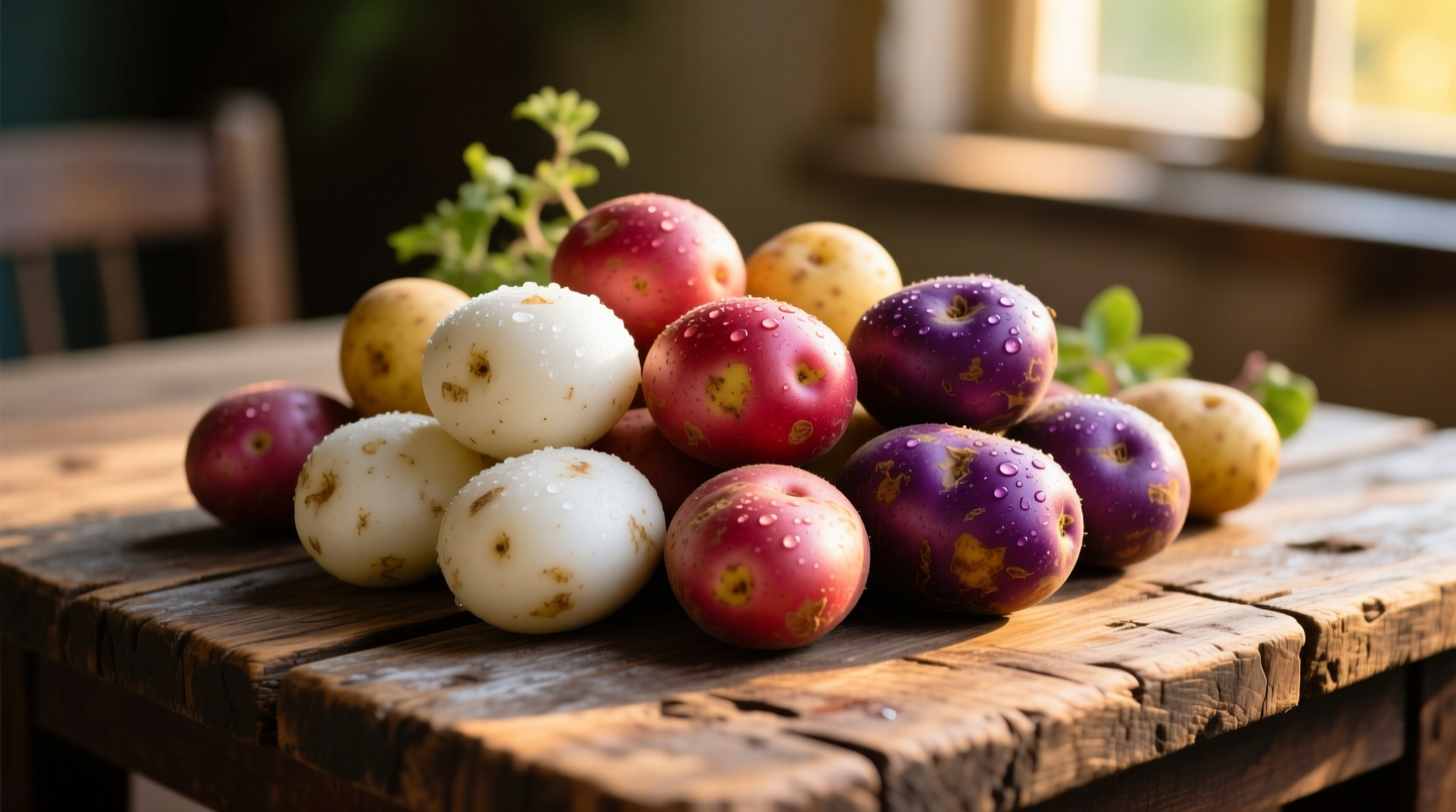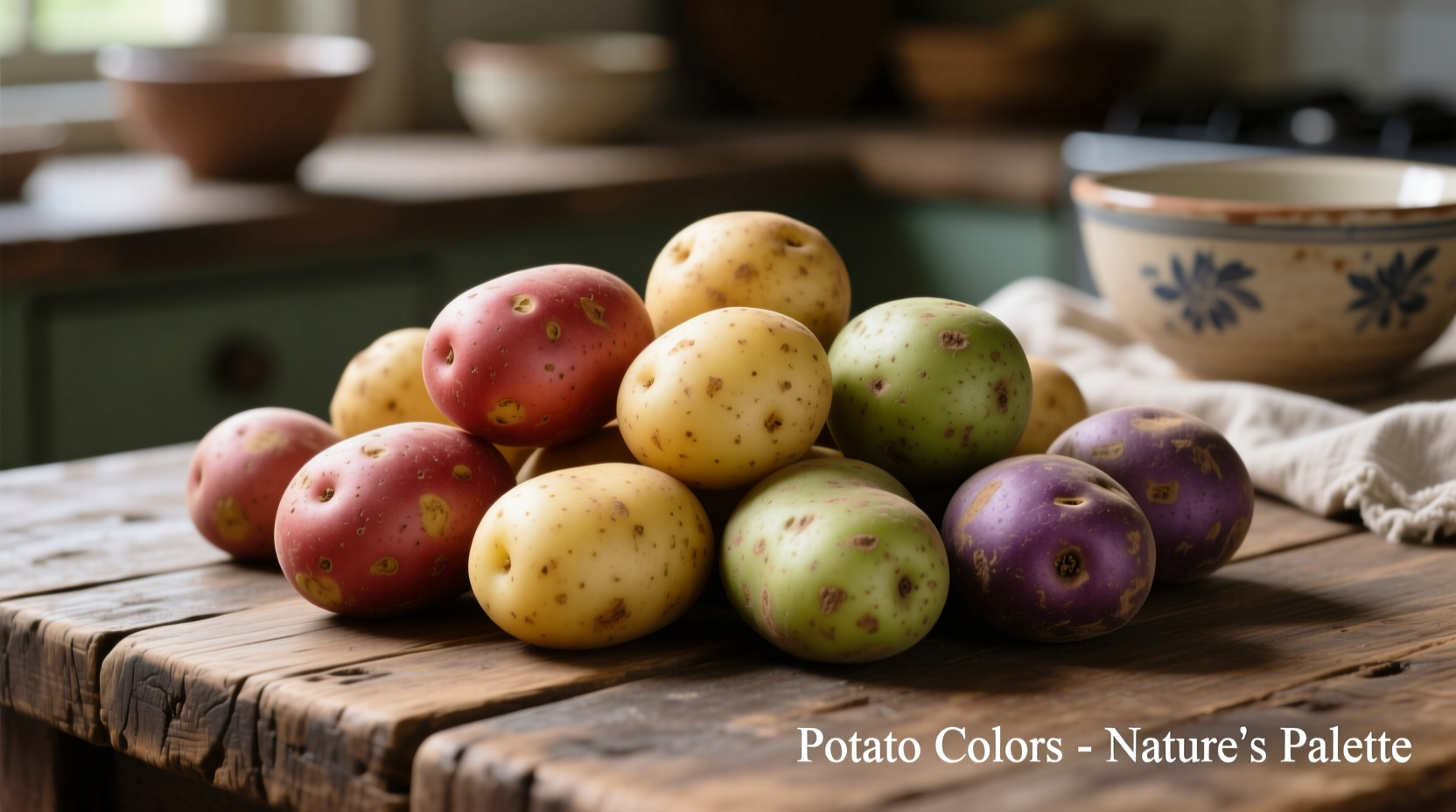Potato colors directly indicate their nutritional profile and culinary properties: white and yellow varieties contain carotenoids for vitamin A, red potatoes have anthocyanins for antioxidants, purple potatoes offer the highest antioxidant levels, and green discoloration signals toxic solanine requiring immediate discard. Understanding these color variations helps optimize both nutrition and cooking results.
Ever wonder why potatoes come in such a vibrant spectrum? From creamy whites to deep purples, potato colors aren't just decorative—they're nature's nutritional labeling system. This guide reveals exactly how to interpret potato colors for better cooking, nutrition, and food safety. You'll learn which colors indicate higher antioxidant levels, when color changes mean spoilage, and how to leverage color differences for perfect culinary results every time.
Why Potato Colors Matter More Than You Think
That russet brown skin or vibrant purple flesh isn't random—it's a visual indicator of specific phytochemicals that affect both nutrition and cooking behavior. Food scientists at the USDA Agricultural Research Service have documented how these pigments directly correlate with nutritional content and starch composition. When you understand potato color coding, you can make smarter choices whether meal planning, grocery shopping, or preparing dishes.
Decoding the Potato Color Spectrum
Each potato color variation stems from different natural pigments. These aren't just cosmetic differences—they fundamentally change how potatoes behave in cooking and what nutrients they deliver.
White and Yellow Potatoes: The Carotenoid Connection
Yellow-fleshed varieties like Yukon Gold get their buttery hue from carotenoids—pigments also found in carrots and sweet potatoes. According to research published in the Journal of Agricultural and Food Chemistry, these carotenoids provide significant vitamin A precursors. White potatoes contain fewer carotenoids but offer excellent all-purpose starch content ideal for mashing and frying.
Red Potatoes: Anthocyanin Powerhouses
Those vibrant red skins contain anthocyanins—the same antioxidants in blueberries and red cabbage. Studies from the American Journal of Potato Research show red potatoes maintain more of these beneficial compounds during cooking compared to boiling. Their thin skins and waxy texture make them perfect for salads where you want potatoes to hold their shape.
Purple and Blue Potatoes: Maximum Antioxidant Density
Purple potatoes like Purple Peruvian contain exceptionally high anthocyanin concentrations throughout both skin and flesh. Research from the USDA confirms these varieties can contain up to four times more antioxidants than white potatoes. Their dense texture holds up well in roasting but requires longer cooking times due to higher dry matter content.
| Color Type | Primary Pigments | Nutritional Advantage | Best Cooking Methods |
|---|---|---|---|
| White/Yellow | Carotenoids | Vitamin A precursors | Mashing, frying, baking |
| Red | Anthocyanins (skin) | Moderate antioxidants | Salads, boiling, steaming |
| Purple/Blue | Anthocyanins (throughout) | High antioxidant density | Rosting, grilling, baking |
The Critical Green Potato Warning
Unlike intentional color varieties, green discoloration in potatoes indicates serious food safety concerns. When potatoes are exposed to light, they produce chlorophyll (causing green color) and simultaneously increase solanine—a toxic glycoalkaloid. According to the FDA's food safety guidelines, green areas should be completely removed as solanine isn't destroyed by cooking. Potatoes with extensive greening should be discarded entirely.
When Color Changes Signal Spoilage
Understanding normal versus dangerous color changes prevents food waste while ensuring safety:
- Brown spots inside: Usually harmless oxidation from exposure to air—still safe to eat
- Black spots: Often bruising from impact—cut away affected areas
- Green tinge: Solanine development—requires careful inspection and possible discard
- Gray discoloration after cooking: Normal reaction in certain varieties when exposed to air
Food safety experts at Cornell University's Department of Food Science emphasize that while minor color variations are normal, any green coloration combined with bitter taste or burning sensation in the mouth indicates dangerous solanine levels requiring immediate disposal.
Practical Applications for Home Cooks
Now that you understand potato color science, apply this knowledge for better results:
Color-Based Cooking Strategies
Waxy red potatoes maintain structure in cold salads while starchy russets create fluffy mashed potatoes. Purple potatoes add visual drama to dishes but can bleed color into surrounding ingredients—pair with acidic components like lemon juice to stabilize their vibrant hue. When roasting mixed potato varieties, cut denser purple potatoes slightly smaller than yellow varieties for even cooking.
Nutritional Optimization Tips
Maximize nutrient retention by keeping skins on colored potatoes—research from the University of Maine shows up to 90% of anthocyanins reside in potato skins. Steam rather than boil colored potatoes to preserve water-soluble antioxidants. Pair purple potatoes with vitamin C-rich ingredients like bell peppers to enhance antioxidant absorption.
Storage Solutions to Prevent Color Problems
Store potatoes in cool, dark places between 45-50°F (7-10°C) to prevent greening. Never refrigerate potatoes as cold temperatures convert starch to sugar, causing undesirable sweetness and darkening when cooked. Keep potatoes away from onions which emit gases that accelerate sprouting. Use breathable containers like paper bags rather than plastic which traps moisture.

Color Misconceptions Debunked
Several common potato color myths persist in home kitchens:
- Myth: All purple potatoes taste earthy—Reality: Varieties like Vitelotte have nutty flavor while others like Congo offer sweet notes
- Myth: Green potatoes are safe if you remove green spots—Reality: Solanine penetrates beyond visible green areas
- Myth: Color indicates ripeness—Reality: Potato color is variety-specific and doesn't change with ripeness
Understanding these distinctions prevents unnecessary food waste while ensuring optimal nutrition and safety. The next time you're selecting potatoes, let their colors guide your choices for both culinary excellence and nutritional benefits.











 浙公网安备
33010002000092号
浙公网安备
33010002000092号 浙B2-20120091-4
浙B2-20120091-4